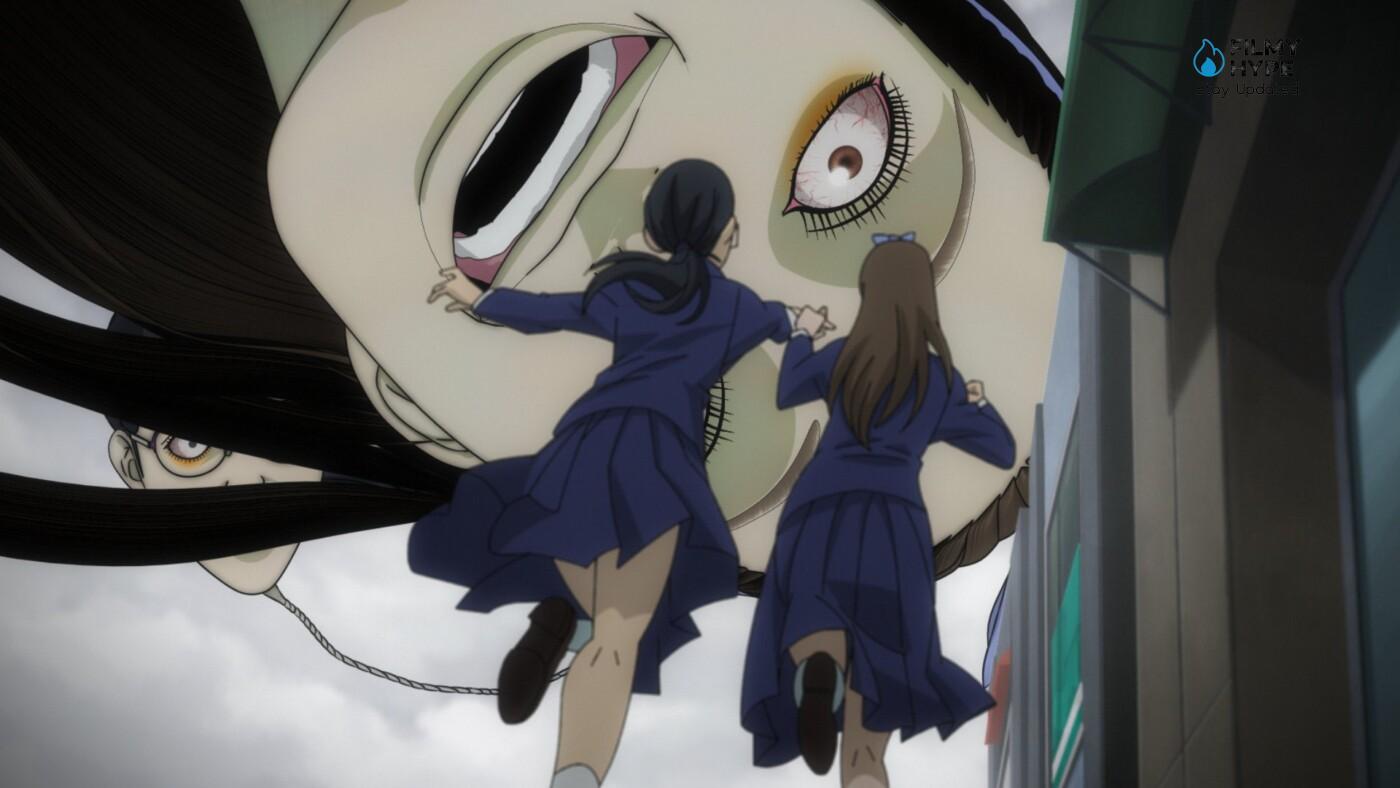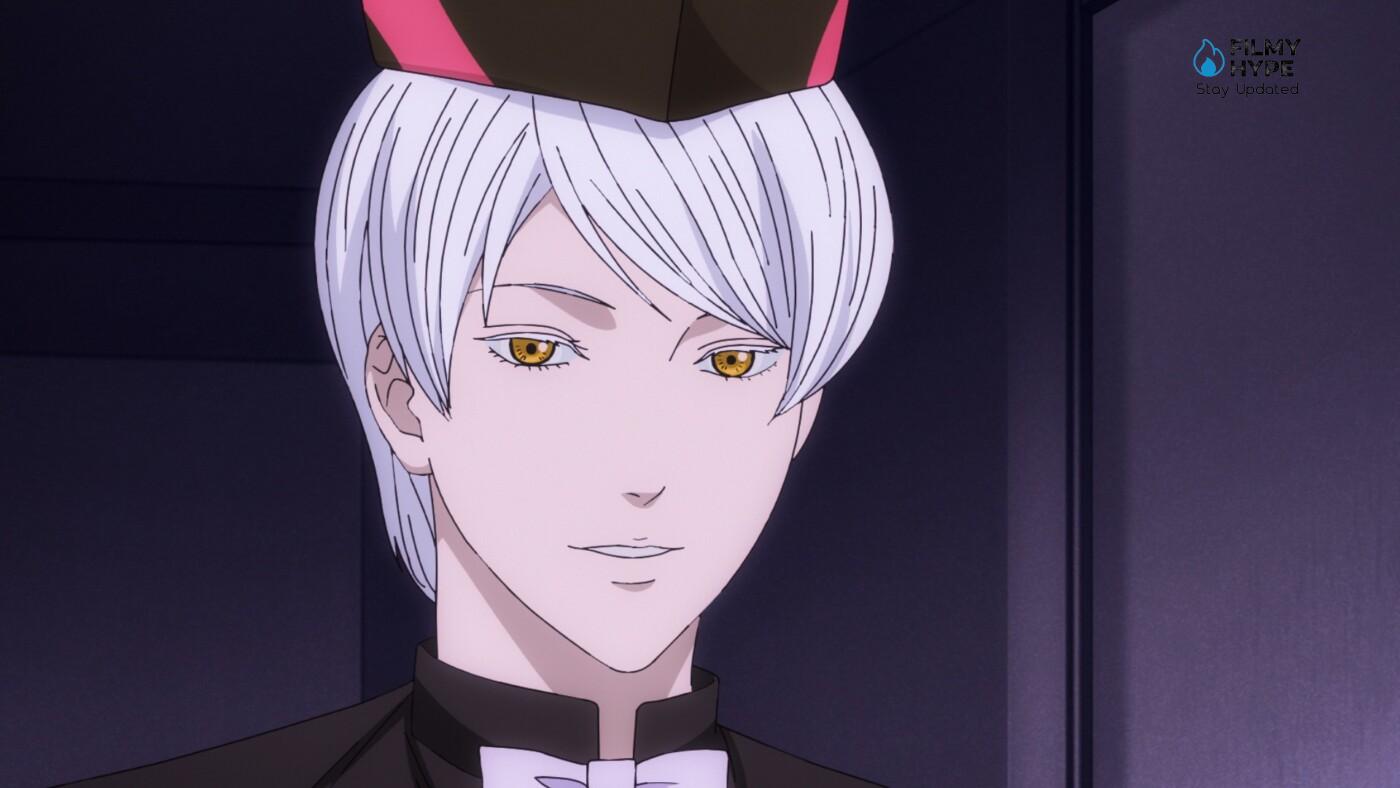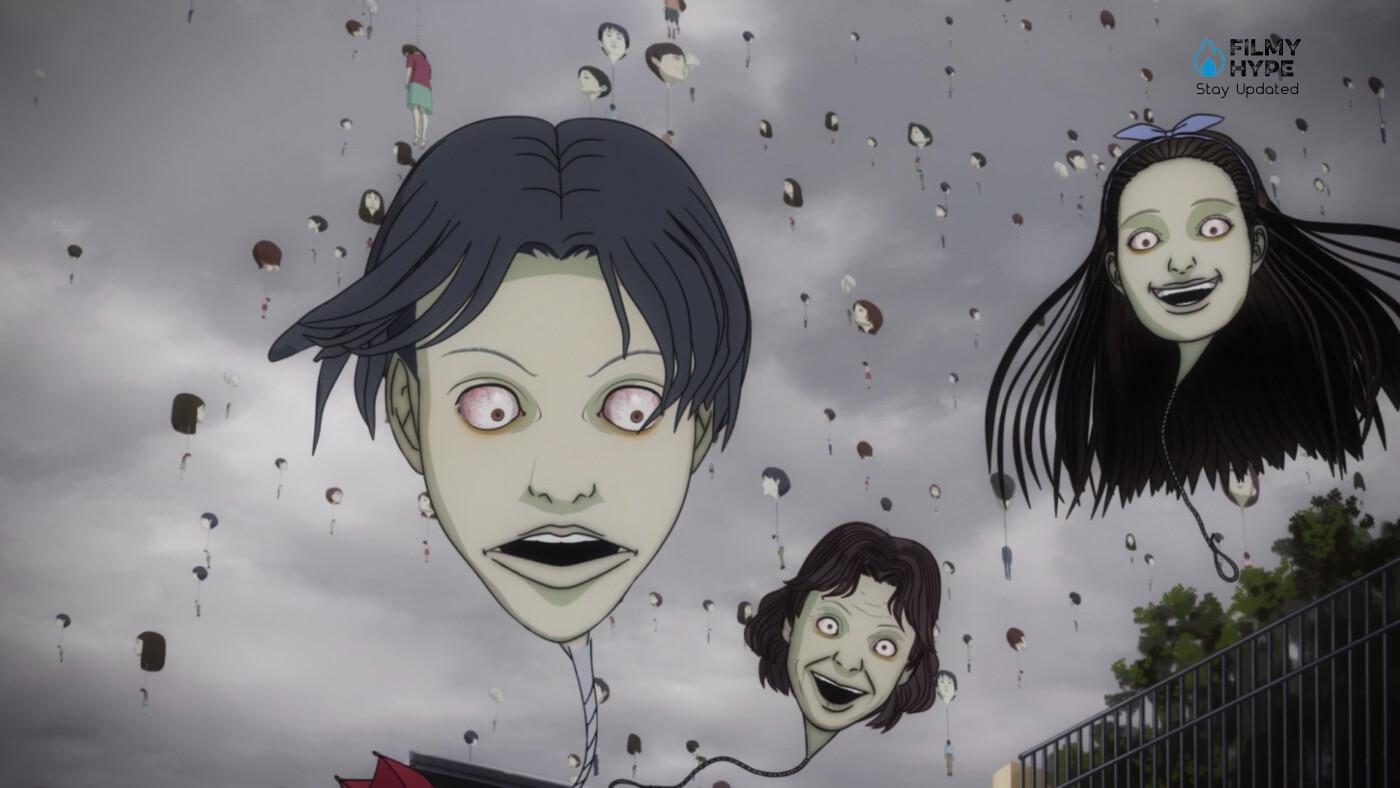Junji Ito Maniac Review: The Re-Reading Of J-Horror Themes on Netflix
Cast: Rie Suegara, Yumiri Hanamori, Yuji Mitsuya, Hiro Shimono
Creator: Shinobu Tagashira
Streaming Platform: Netflix
Filmyhype.com Ratings: 3/5 (three stars) [yasr_overall_rating size=”large”]
The Junji Ito Maniac anime series, produced by Studio Deen, directed by Shinobu Tagashira, and written by Kaoru Sawada is available on Netflix from January 19, 2023. The series, which adapts twenty stories by the mangaka Junji Ito, is an ideal sequel to the 2018 Junji Ito Collection, also by the same authors. Fans of the horror genre are constantly hungry for stories full of thrills, and Netflix seems to want to satisfy them all the time. Precisely thanks to the creative and distributive freedom within the streaming giant, only in the last few months have we had the opportunity to enter Guillermo del Toro’s Cabinet of Curiosities, an experiment that united different authors to give life to eight different scary stories.

Almost as if it were a thematic continuation, here then is that one of the most famous mangakas in the horror genre finds animated lifeblood for some of his stories. Junji Ito, for years considered the king of Japanese thrills, thanks to his stories full of mystery and fear and the dark and decisive line of the drawing, is the only author from whom this 12-episode anthological series was born, which he intends to adopt in anime version some of his works. As we will see in our Junji Ito Maniac review, Netflix’s horror anime has to deal with twenty different stories, of varying duration, which, despite having the same matrix in common, give rise to fluctuating and different results.
Junji Ito Maniac Review: The Story Plot
There is no real plot inside Junji Ito Maniac. The twenty stories that make up the 12 episodes of the season vary from cosmic to gothic horror, between haunted houses and moments worthy of the best splatter, not without – always in an alternating and discontinuous way – a pinch of dark humor which on certain occasions is a winner (and, in others, instead, it appears almost out of place). It begins with the story of a particular family of six brothers intent on being visited by a curious photographer (one of the worst episodes and a bad business card for the series) and continues with stories concerning a tragic past, a mysterious little man ice creams and strange giant balloons (second and third episodes among the most convincing). But there is also an opportunity to tell of strange, beached sea creatures that hide secrets,
There is something for all tastes and the horror story enthusiast can only feel a great sense of curiosity in pressing Play and being surprised by the different drifts that every single episode will take. The result, however, is a discontinuous series, paradoxically precisely because of its merits: the diversity of every single story naturally produces episodes that are more convincing than others and more exciting than others and Ito’s pen tends to recognize itself more and more. Different subjects developed by the same author can only gradually begin to resemble each other, making the surprise effect on the narrative drifts lose much of it.
Junji Ito Maniac Review and Analysis
The episodes that makeup Junji Ito Maniac quite faithfully return to Ito’s figurative universe and its themes. These are small surreal stories that in some cases recall recurring figures of the author’s production, such as Soichi, the unpleasant little boy with iron deficiencies who loves to torment others, or Tomie, a sort of female figure emblematic of the demonic power that can hide behind the beauty. However, each story is self-contained and represents a small world of its own. The authors try to give a specific identity to each episode, through the expressive use of colors and visual devices such as vignettes and video noise, to imitate the transmission of a horror film on a CRT TV (The bizarre Hikizuri brothers ), the 4:3 aspect ratio to mimic the old analog photographic format (Tomie – Photography) or even black and white to tell a world invaded by mold, that is, deprived of the colors of life (Muffa).
The animations unfortunately have some weaknesses, such as the lack of fluidity and the almost total fixity of the backgrounds. The stroke of the drawing mimics that of Ito but is lacking in excessive cleanliness and, somehow, in the adaptation from the paper drawing to the animated one, there is a sort of normalization of an otherwise truly original aesthetic. The stories revolve around some central thematic nuclei, typical of the J-Horror imagery, filtered by Ito’s reinterpretation. Of the 12 episodes that make up the season of Junji Ito Maniac, in 4 there is only one story lasting 25 minutes. The rest of the season is made up of double episodes, where the stories last approximately 10 minutes (although the length varies according to the single story). While watching the twenty stories, very few times do you feel like you have witnessed a cohesive and compact story, perfect in rhythm and with an ending that arrived at the right time.

If on certain occasions the 25 minutes are even too much (this is the case of the aforementioned first episode, The bizarre Hikizuri brothers, for example), on other occasions the 10 minutes dedicated to a single story seem too few to give life to an ending completely satisfactory. Often, therefore, the feeling is that the end credits arrive right at the climax, interrupting a story that was proving to be interesting up to that moment and which gives a sense of incompleteness. Sure, in the horror genre, we expect a hanging or open ending, but not a sudden one. Often the cause of this sudden end can be found in the dialogues, intent on explaining the whole story to the viewer in detail, often excessively (the characters say aloud what they feel, how they feel, what they have done: everything we have seen through the images) and highlighting the literary nature of the works. But if in a comic, which needs a fixed and precise image to carry on the narration, these explanations can find meaning, in an audiovisual adaptation everything appears redundant and cumbersome, to break that aura of mystery and tension that would serve many stories.
Even if all that glitters is not gold, Junji Ito Maniac offers some experimental moments, both in the technical field (some stories in black and white, others in 4:3 format, and still others with brighter or duller colors) and in the visual one. Here, where the series manages to translate the mangaka’s madness is precisely in certain sequences that find their raison d’être precisely by the animation, resulting in scary and impressive. The third episode (Hanging balloons) or the story The long hair in the attic (present in the fifth episode) is successful thanks to the possibilities of the drawing, which support Ito’s absurd and – for this reason – terrifying stories in the best way.
With a focus on the mental insanity that infects the protagonists of the stories, the best episodes manage to go beyond simple entertainment and use the horror genre to tell the nightmares of our days. Particularly effective is Layers of Terror, a ravenous and neurotic body horror that manages to condense animation, brilliance, terror and despair into just over 10 minutes. In these rare cases, we find a precise and singular voice, which the risk of binge-watching tends to stifle.
A second thematic nucleus can be identified precisely in the home/family dead. Home in Ito’s world is not a safe and loving space. It is a place where various dark dimensions (of the soul) intersect, generated by those grudges, hypocrisy, and regrets, hidden behind concepts such as parental or filial love, when they are inserted in a social context that favors hierarchies and appearance, to the detriment of the reality of feelings. The houses in Ito, therefore, have multiple layers, and hollow walls and are connected to infernal and muddy spaces, from which anything can emerge. The members of the family units, in turn, are victims of a slow but inexorable mutation – sometimes only moral – which reveals a monstrous or pathetic nature (The bizarre Hikizuri brothers, Quattro mura, The Intruder, Layers of Terror, Back Alley ).
This theme is linked to the representation of contemporary Japanese society. It is described as a civilization emptied of any logical sense, marked by emotional repression and an individualistic egoism typical of the generation of the moratorium, the moratorium nigen. That is, of a generation made up of adults, immersed in consumerism, who try to procrastinate a youthful condition devoid of responsibility. The individual and social choices, the result of such wishful thinking, however, end up colliding with the consequences produced by reality, in which the metaphysical powers of the Shinto or Buddhist traditions still operate (The story of the mysterious tunnel, The ice cream bus, The Lair of the Sleep Demon, Hallucinations in the Library, Unbearable Labyrinth, Soichi’s Pet).

Finally, the fourth thematic nucleus revolves around the relationship that corporality maintains with the psyche, on the one hand, and with the natural and inorganic world, on the other. In the typical tradition of Japanese fantasy, a plethora of bodies in a state of becoming object is staged, so to speak, or if you like, organic and inorganic objects that take on human traits, with the sole purpose of bringing out the hidden (and removed) sides of a collective and individual psyche, which always seems destined for annihilation (Hanging balloons, The city of tombstones, Objects washed ashore, Mold, Headless sculptures).
The entire sensible reality, for Ito, is only a patina, which can be torn off suddenly, through a gash or a wound, inflicted on the human organic unit. From this glimpse, the suffering identities of victims and perpetrators can open up to the dark spiritual universe that is hidden behind the mask of life. A last note to make about Junji Ito Maniac concerns the decision to set the anime in the nineties, a period in which many of the stories were published. A similar philological choice, underlined by the final theme that thematizes the nostalgic totem of CRT TV inserts (and would like to reduce) Ito’s universe within the J-Horror imagery of the time, in Ringu style (Nakata, 1998). Once again, the Netflix platform is trying to build its communication strategies around an aesthetic of nostalgia which, having worn out the fashion of the Eighties, now seems to be turning towards the Nineties.
Junji Ito Maniac Review: The Last Words
Junji Ito Maniac contains twenty different horror genre stories taken from the mangaka’s works. Ito’s voice is recognizable and, in the long run, the surprise effect is somewhat lost, also thanks to a not-always-centered writing that gives the impression of stories suspended in the middle. The anthological series, however, in the best moments, offers truly effective stories that know how to worry the viewer. The result is a series of stories of fluctuating quality that will interest fans of the genre.


